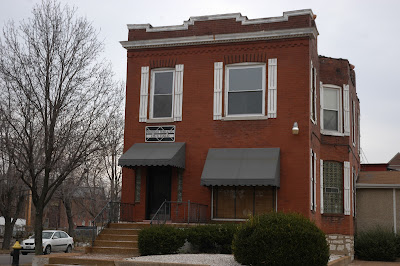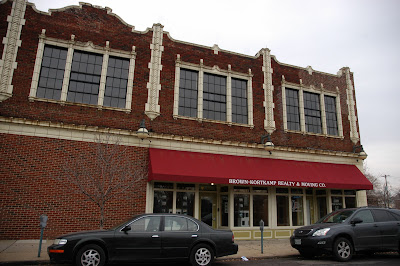The 2000 census data counted 1,804 residents (down 23% from 1990's count) of whom 99% were black. There were 1,010 housing units counted, 75% occupied (32%/68% owner/renter split). 2010 census data counted 1,484 people, another 18% loss, down to 17 white people, 1,445 black people, 7 Hispanic/Latino and 1 Asian.
From the Fountain Park website:
The Neighborhood is renowned for large stately houses, accessible shopping, convenient transportation, schools and numerous black churches within a stable community. Neighbors have organized and formed block units and neighborhood associations designed to maintain and improve the culture of the area. Two of these organizations are: The Enright Neighbors, and the Fountain Park Block Unit."Stable community" are not words that could be used to describe current day Fountain Park by most objective people. I must admit this is my second attempt at photographing this neighborhood. To make a long story short, I was convincingly asked to get the #$%& out the first time. The drug trade is alive and well on some streets in Fountain Park and it's as obvious and out in the open as can be.
The homes are regularly maintained. A few of the homes have been secured by private developers for rehab. These homes are available to potential neighbors, interested in becoming a part of the history of a solid family orientated neighborhood. Neighbors regularly gather to improve the neighborhood and support each other. They participate in the Operation Brightside clean-up and the National Night Out.
If you can't make it out, the painted message on this abandoned property reads "No Loitering, Drinking or Drugs".
I'll tell some stories later when I get done with all the neighborhood profiles and will write a post on my run ins with racism, drugs, homelessness and prostitution in some parts of town. Today I got stopped by a caring policeman who questioned me as to my business in Fountain Park; he seemed somewhat interested and asked me to be safe. I appreciated him looking out for me.
Anyhow this neighborhood has seen it's share of bad behavior and carelessness that can't be ignored. It's a damn shame as this neighborhood is literally right across the street (Delmar Blvd.) from what most consider the bastion of urbanity and style and class: the Central West End neighborhood.
A beautiful church anchors the southwest side of the park:
And the fountain for which the park takes it's name is an eye catching centerpiece for the park, as well as a monument to Dr. Martin Luther King Jr that was unveiled in 1978.
There is an awesome building built in 1897 that occupies the northeast side of the park. It's a phenomenal structure and should be on the top 10 list of MUST SAVE places in this town. Today it sits uncared for and in wait for someone with the guts to save it.
Notice some weird commentary that exists on the building today:
Many others have written about this particular building: B.E.L.T., UrbanReviewSTL, Built St. Louis.
The 1.5 acre park was donated in 1889 by the gentlemen (John Lay) that laid out the neighborhood in 1857, then called Aubert Place. More on the history of the park and the fountain (source):
When the Aubert Place subdivision was laid out by John Lay in 1857, a central oval shaped area was reserved for a park space. In 1889, it was donated by Lay to the city and was named Fountain Park, because of the fountain that was placed there was as a gift from the Merchants Exchange. It had been in the Exchange's trading hall for some years as a gift from John A. Scudder. Previously, it had graced Scudder's home near Grand Avenue and Olive Street. As an outdoor fountain, it proved to be a failure. It was constructed of flimsy materials causing the figures to be blown down during any ordinary storm. Also, the diameter of the iron ground basin was too small in comparison to the height of the fountain, causing the spray to be carried outside of the basin by the wind. During 1904, both the old house and the large fountain received two coats of paint to improve the appearance of the area. The fountain was renovated in 1964.There are some overwhelming obstacles to the neighborhood regaining it's original charm. Here are a couple examples of modern suburban failures (note the ample parking for....nothing):
William Severson of Ladue was the sculptor for the renovation of the fountain and Karl Kraus was the contractor. The cost of this renovation was $4,660. The work was done as part of $15,400 renovation of the park. The work was paid for out of the 1955 Bond Issue funds.
The process employed included creation of molds of details that were missing by using those details that remained. Details were cast from the molds using epoxy reinforced by fiberglass cloth. The main body of the fountain was sand blasted and repainted with zinc epoxy to protect and preserve it. New plumbing was installed and the interior of the fountain was filled with concrete to add strength. Epoxy glass cloth reinforcement was applied to the existing bowls.
The original fountain material was cast iron that had become badly pitted by the time of the renovation. It was estimated that the fountain had been in service over 50 years when finally renovated. It was the opinion of the sculptor that the renovation work had left the fountain in better condition then when it was cast.
And then there is the crumbling housing stock that is impossible to ignore and must be shown to give you a feel for what this neighborhood is like today:
The bones of a great neighborhood are still here though, here are a couple of my favorites:
And here are a couple examples of the more contiguous stretches of inhabited homes:
There are several handsome and significant structures in Fountain Park. Euclid School:
A classic St. Louis firehouse:
The Missouri Terrazzo flooring company has a well maintained building that really stands out as a well maintained beauty (note the cool shutters):
Here's some stuff that caught my attention today:
Sights along Kingshighway between Delmar and MLK:
Delmar still has some amazing buildings in Fountain Park.
The Vault (pictured above) was a former bank renovated to a nightclub at one point. Check out this description:
After a $3 million renovation, The Vault (a former bank, hence the name) has earned a reputation among the premier night clubs in St. Louis. The dance floor is the largest in the city and the upscale motif attracts club heads, celebutants, and folks just looking to have a good time. Those with two left feet can still impress a date by displaying stellar skills on the pool table in the game room adjacent to the dance floor. And if all else fails, the highly skilled bartenders will prepare a cocktail to make anyone look more attractive among the luxurious gold mirrors and lavish couches. Make sure to check out the VIP room, which once was an actual bank vault.Mmmm celebutants and gold mirrors, a tasty combination indeed...
The area around Fountain Park is a must see, go check it out. Maybe the more people that take notice, attention will be drawn to a place that clearly needs to be saved for future generations to enjoy.









































Fountain Park is amazing! Back in the day, the neighborhood was heavily Jewish. The #15 Hodiamont streetcar line (or Suburban Tracks) ran right through the neighborhood, and there are still a few signs to be found along the right-of-way. I hope this hood comes back-- it is a Saint Louis treasure.
ReplyDeleteHere is a great site that has a lot of memories posted by someone that lived in this neighborhood a long time ago. There were apparently a lot of Greeks in this area, too. My grandfather and great-grandparents (last name Nanos) are mentioned in a few of the stories, which is pretty neat.
ReplyDeletehttp://www.vlanton.com/761_aubert/greekschool.htm
Man...I remember this as if it were yesterday. This place holds the best period of my childhood('95-'98), much due to the friends that I had at the time. It doesn't look extremely different. The last time I drove through(2011), it seemed a little rougher & more neglected than before(with so many more houses abandoned). Still, it's structure, scenery & surrounding areas made it a very interesting place, so we had many adventures. We've been in & on top of that building in the picture above The Vault(while it was abandoned; 8-13 yr old kids?!), & have walked through that park so many times. That first abandoned parking lot used to be a Schnucks, & immediately across the street from the house with 'No loitering...' was a corner store that we frequented. Speaking Of corner stores, I hate that no one has a picture of Mr. Beck's that was on Bayard(it was gone, last I checked); It was classic & he seemed to be a good old man. This is all very familiar to me, so I'm sorry for carrying on. Thank you so much for this.
ReplyDeleteI writting a research paper and fountain park is one of the neighborhoods i picked to talk about. I need some help
ReplyDeleteoh st louis, you are breaking my heart. these proud old homes, these once friendly neighborhoods. it's not too late
ReplyDeleteI remember the neighborhood of Warne and Lee and Fairview Park on Saturday evenings in the 1960s.
I haven't been back for many years but the people who live there deserve so much better
I lived at 4825 a Fountain during the late 1950's and until the early 1960's. This neighborhood was just beginning to decline but still had some middle class African American families residing in the area. I remember on the corner of Bayard and Fountain was a confectionary store owned by the name of Steve last name unknown. I believe he was either Jewish or possibly Greek. Most of the neighborhood shopped at this grocery store. This was long before Sols savaged moved into the neighborhood. I remember that it was very cleaned and that Steve had very dark features and a strong accent. He along with his brother remained business owners in that community for years until they were both later slain during robberies. A lot of the students from Washington and Euclid Schools would go to Steve's grocery store at lunch time for donuts, pickles, and peppermint candy. I can still recall smelling the combination of peppermint candy and pickles in the classroom after lunch. Next to Steve's grocery store was a small confectionary store which was ran by a African American lady name Ms. Bea. I still remember that she had the best coconut cookies for 1 cent a piece. Around the corner from Steve's in the same building was a local popular bar. Everyone pretty much knew everyone's family in this community. A lot of the mansions or larger homes had been remodeled to accommodate one or two rooms for renters. Once that happened it just seemed the neighborhood started to change. Later during late 1960's and early 1970's the drug problem slowly crept into this community and that's when the neighborhood started to really decline. The middle class families slowly started moving further west to the suburbs which didn't help these old communities either. My Mother still recalls when Fountain park was so safe that people often slept in the park during those hot humid summers. Unfortunately a lot has changed since then. I can only hope that St. Louis would see the beauty in restoring this old community.
ReplyDelete